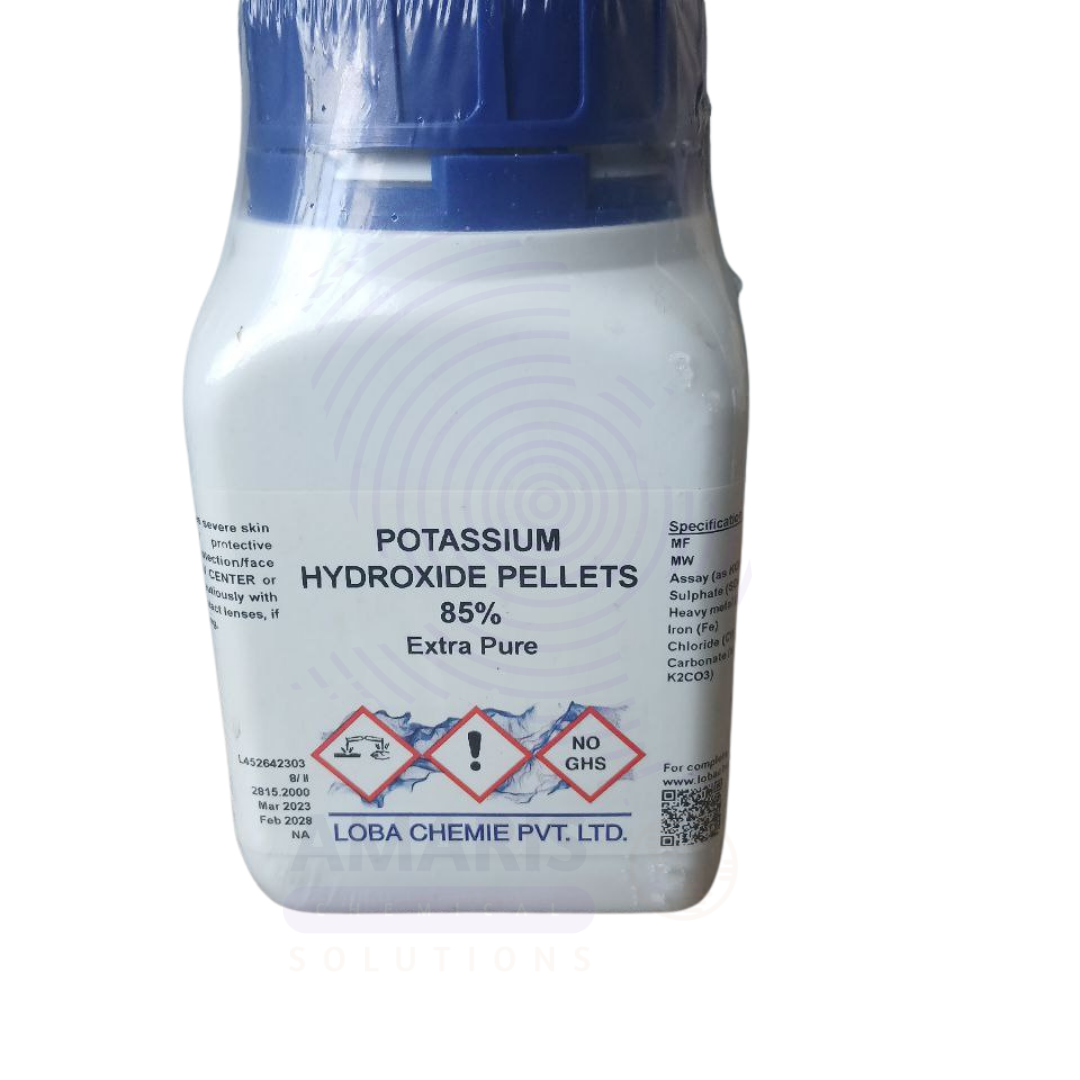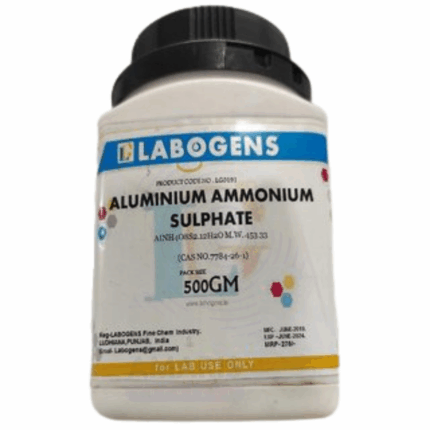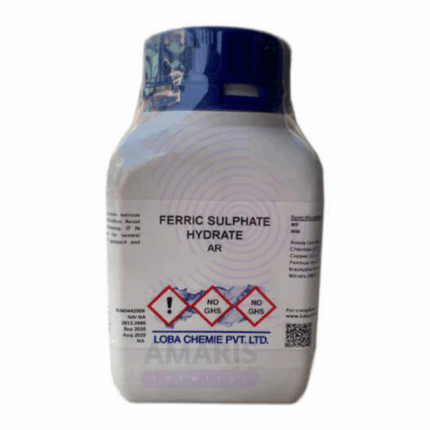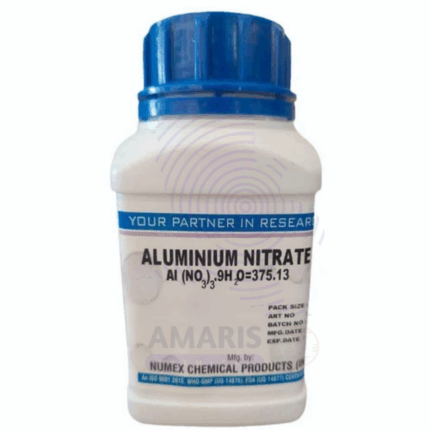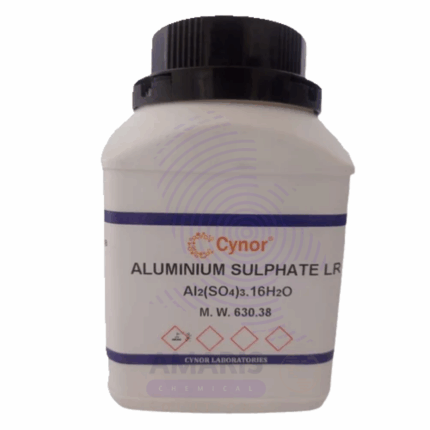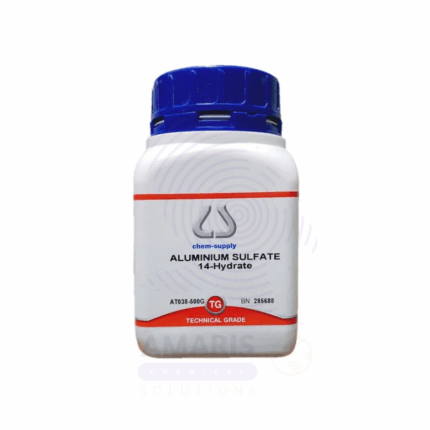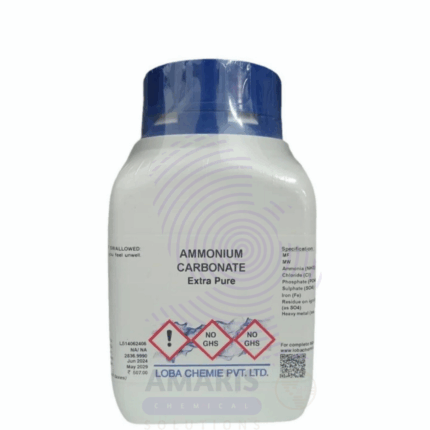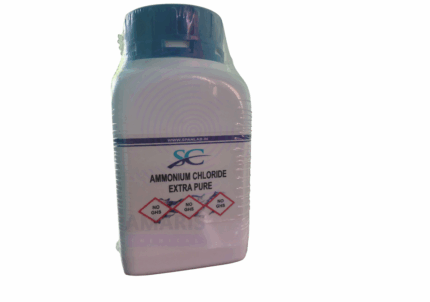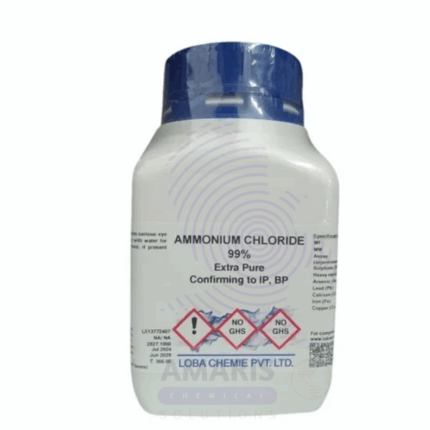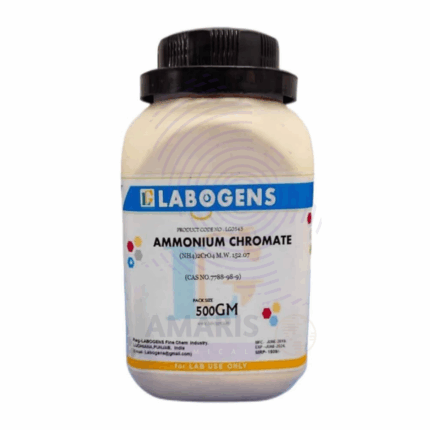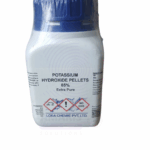
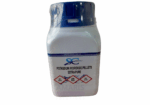
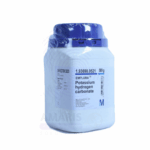
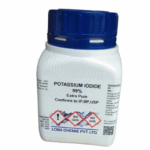
Potassium Hydroxide Pellets Extra Pure
$ 29.79 Original price was: $ 29.79.$ 19.67Current price is: $ 19.67.
Potassium Hydroxide Pellets Extra Pure are solid, white, hygroscopic pellets known for their strong alkalinity and high reactivity. This compound is widely used in laboratories for pH adjustment, titrations, and chemical synthesis. In industrial settings, it plays a key role in soap and detergent manufacturing, biodiesel production, and water treatment processes. Its ability to absorb moisture and carbon dioxide from the air requires careful storage in airtight containers. With exceptional purity and consistent performance, it is a critical reagent in both academic and industrial chemistry environments.
Potassium Hydroxide Pellets Extra Pure
PRIMARY USES
- Chemical Manufacturing:
- Essential for producing potassium-based compounds like potassium carbonate, potassium soaps, and potassium phosphates.
- Used in the manufacture of biodiesel as a catalyst for transesterification.
- Soap and Detergent Industry:
- Used in the production of soft/liquid soaps (potassium soaps), offering better solubility than sodium-based soaps.
- Acts as a strong alkaline cleaner in industrial detergents.
- Laboratory Applications:
- Common strong base for acid-base titrations.
- Used in preparing buffer solutions and as a reagent in various synthesis reactions.
- Battery Industry:
- Used as the electrolyte in alkaline batteries, particularly nickel-cadmium and nickel-metal hydride batteries.
- Petroleum Industry:
- Employed in petroleum refining for removing acidic impurities and in oil & gas drilling fluids.
SECONDARY USES
- Textile Industry:
- Used in scouring and bleaching cotton and synthetic fibers.
- Acts as a merchandising agent to improve fabric strength and luster.
- Food Industry (regulated use):
- Occasionally used as a pH regulator, stabilizer, or thickener (E525), under strict controls.
- Pharmaceuticals:
- Involved in the preparation of some medicinal ointments and creams requiring high alkalinity.
- Used in compounding lotions, especially for treating warts and skin conditions.
1. Basic Identification Attributes
- Chemical Name: Potassium Hydroxide
- CAS Number: 1310-58-3
- HS Code: 2815.20.00
- Molecular Formula: KOH
- Synonyms:
- Caustic potash
- Potash lye
- Lye (potassium)
- KOH pellets
2. Physical & Chemical Properties
- Physical State: Solid (pellets or flakes)
- Color & Odor: White or slightly off-white; odorless
- Boiling Point & Melting Point:
- Melting Point: ~360 °C
- Boiling Point: ~1320 °C (decomposes)
- Density/Specific Gravity: ~2.04 g/cm³
- Solubility:
- Highly soluble in water (exothermic reaction)
- Soluble in ethanol and glycerol
- pH Level: >13 (strongly alkaline in solution)
- Vapor Pressure & Volatility: Negligible vapor pressure
- Flash Point: Not flammable
- Autoignition Temperature: Not applicable
- Viscosity: Not applicable (solid)
3. Safety & Hazard Attributes
- Hazard Class (GHS Classification):
- Corrosive to skin and eyes (Skin Corr. 1A)
- Causes severe burns and eye damage
- NFPA Ratings:
- Health: 3
- Flammability: 0
- Reactivity: 1
- Exposure Limits:
- ACGIH TLV-C: 2 mg/m³ (ceiling limit)
- Reactivity:
- Reacts violently with acids and water
- Generates heat and can cause splattering when dissolved in water
4. Storage & Handling Attributes
- Storage Conditions:
- Store in tightly sealed containers
- Keep in cool, dry, and well-ventilated area
- Protect from moisture (hygroscopic)
- Incompatible Materials:
- Acids, aluminum, organic halogens, nitro compounds
- Container Type:
- Plastic (HDPE), stainless steel; avoid glass for strong solutions
- Shelf Life & Expiration Date:
- Indefinite if kept dry and sealed
- Special Handling Requirements:
- Use gloves, goggles, face shield, and lab coat
- Work in well-ventilated area or fume hood
- Add pellets slowly to water, never the reverse
5. Regulatory & Compliance Attributes
- Regulatory Status:
- Regulated by OSHA, EPA, REACH, and DOT
- Listed under TSCA inventory
- Transportation Restrictions:
- UN Number: UN1813
- Class: 8 (Corrosive)
- Packing Group: II
- Waste Disposal Method:
- Neutralize with acid and dilute before disposal
- Follow local, regional, and national regulations
6. Environmental & Health Impact
- Ecotoxicity:
- Harmful to aquatic organisms due to high alkalinity
- Persistence in Environment:
- Reacts with CO₂ to form potassium carbonate
- Carcinogenicity/Mutagenicity:
- Not classified as carcinogenic or mutagenic
- Biodegradability:
- Inorganic; does not biodegrade but neutralizes in environment
- Inorganic; does not biodegrade but neutralizes in environment
SAFETY PRECAUTIONS
Personal Protective Equipment (PPE):
- Chemical splash goggles or full face shield
- Lab coat or chemical-resistant apron
- Neoprene or nitrile gloves (highly resistant to alkalis)
- Respiratory protection if dust is generated
- Enclosed footwear
Handling:
- Avoid contact with skin, eyes, and clothing.
- Do not inhale dust or fumes.
- Always add pellets to water slowly—never add water to pellets (exothermic reaction).
- Handle under a fume hood or well-ventilated area.
Storage:
- Store in a tightly sealed, corrosion-resistant container.
- Keep in a dry, cool, well-ventilated place.
- Hygroscopic: protect from moisture and air exposure.
- Segregate from acids, oxidizers, and flammable materials.
FIRST AID MEASURES
Inhalation:
- Remove the person to fresh air immediately.
- Provide oxygen if breathing is difficult.
- Seek medical attention promptly.
Skin Contact:
- Immediately flush skin with large amounts of water for at least 15 minutes.
- Remove contaminated clothing and shoes.
- Get medical assistance urgently—even if irritation appears mild.
Eye Contact:
- Rinse eyes with water for at least 15–20 minutes while holding eyelids apart.
- Seek emergency medical help immediately—can cause severe damage or blindness.
Ingestion:
- Rinse mouth; do not induce vomiting.
- Drink water or milk if conscious.
- Seek immediate medical help—severe burns to mouth, throat, and stomach may occur.
FIRE FIGHTING MEASURES
Flammability:
- Not flammable but highly reactive.
Extinguishing Media:
- Use dry chemical, CO₂, or alcohol-resistant foam for surrounding fire.
- Do not use water directly on potassium hydroxide—it reacts violently with water and generates heat.
Hazardous Combustion Products:
- Emits toxic fumes of potassium oxide and may produce heat on reaction with water.
Firefighter Protection:
- Use self-contained breathing apparatus (SCBA) and full protective gear.
- Approach fire from upwind to avoid caustic vapors.
Related products
Aluminium Ammonium Sulphate Extra Pure
Aluminium Ferric Sulphate Extra Pure
Aluminium Nitrate Extra Pure
Aluminium Sulphate Anhydrous Extra Pure
Aluminium Sulphate Hydrous Extra Pure
Ammonium Carbonate Extra Pure
Ammonium Carbonate Extra Pure is a high-quality, white crystalline solid widely used across various scientific, industrial, and food-related applications. Manufactured to stringent purity standards, this compound is ideal for laboratories and processes that demand high-grade reagents. With its characteristic ammonia-like odor and ability to decompose upon heating, ammonium carbonate plays a versatile role in both chemical reactions and physical processes.
In aqueous solution, ammonium carbonate breaks down into ammonium bicarbonate and ammonium carbamate, further releasing ammonia (NH₃) and carbon dioxide (CO₂) upon heating. This property makes it especially useful in applications that require controlled gas release or temporary pH modification.


 Preservatives(food)
Preservatives(food) Flavor Enhancers
Flavor Enhancers Acidulants
Acidulants Sweeteners
Sweeteners Antioxidants
Antioxidants Colorants(food)
Colorants(food) Nutraceutical Ingredients (food)
Nutraceutical Ingredients (food) Nutrient Supplements
Nutrient Supplements Emulsifiers
Emulsifiers
 Collectors
Collectors Dust Suppressants
Dust Suppressants Explosives and Blasting Agents
Explosives and Blasting Agents Flocculants and Coagulants
Flocculants and Coagulants Frothers
Frothers Leaching Agents
Leaching Agents pH Modifiers
pH Modifiers Precious Metal Extraction Agents
Precious Metal Extraction Agents
 Antioxidants(plastic)
Antioxidants(plastic) Colorants (Pigments, Dyes)
Colorants (Pigments, Dyes) Fillers and Reinforcements
Fillers and Reinforcements Flame Retardants
Flame Retardants Monomers
Monomers Plasticizers
Plasticizers Polymerization Initiators
Polymerization Initiators Stabilizers (UV, Heat)
Stabilizers (UV, Heat)
 Antifoaming Agents
Antifoaming Agents Chelating Agents
Chelating Agents Coagulants and Flocculants
Coagulants and Flocculants Corrosion Inhibitors
Corrosion Inhibitors Disinfectants and Biocides
Disinfectants and Biocides Oxidizing Agents
Oxidizing Agents pH Adjusters
pH Adjusters Scale Inhibitors( water)
Scale Inhibitors( water)
 Antioxidants(cosmetic)
Antioxidants(cosmetic) Emollients
Emollients Fragrances and Essential Oils
Fragrances and Essential Oils Humectants
Humectants Preservatives
Preservatives Surfactants(cosmetic)
Surfactants(cosmetic) Thickeners
Thickeners UV Filters
UV Filters
 Fertilizers
Fertilizers Soil Conditioners
Soil Conditioners Plant Growth Regulators
Plant Growth Regulators Animal Feed Additives
Animal Feed Additives Biostimulants
Biostimulants Pesticides (Herbicides, Insecticides, Fungicides)
Pesticides (Herbicides, Insecticides, Fungicides)
 Active Pharmaceutical Ingredients (APIs)
Active Pharmaceutical Ingredients (APIs) Excipients
Excipients Solvents(pharmaceutical)
Solvents(pharmaceutical) Antibiotics
Antibiotics Antiseptics and Disinfectants
Antiseptics and Disinfectants Vaccine Adjuvants
Vaccine Adjuvants Nutraceutical Ingredients (pharmaceutical)
Nutraceutical Ingredients (pharmaceutical) Analgesics & Antipyretics
Analgesics & Antipyretics
 Analytical Reagents
Analytical Reagents Solvents(lab)
Solvents(lab) Chromatography Chemicals
Chromatography Chemicals Spectroscopy Reagents
Spectroscopy Reagents microbiology-and-cell-culture-reagents
microbiology-and-cell-culture-reagents Molecular Biology Reagents
Molecular Biology Reagents Biochemical Reagents
Biochemical Reagents Inorganic and Organic Standards
Inorganic and Organic Standards Laboratory Safety Chemicals
Laboratory Safety Chemicals Specialty Laboratory Chemicals(Special Laboratory Equipment)
Specialty Laboratory Chemicals(Special Laboratory Equipment)
 Demulsifiers
Demulsifiers Hydraulic Fracturing Fluids
Hydraulic Fracturing Fluids Scale Inhibitors(oil)
Scale Inhibitors(oil) Surfactants(oil)
Surfactants(oil) Drilling Fluids
Drilling Fluids
 Dyes and Pigments
Dyes and Pigments Bleaching Agents
Bleaching Agents Softening Agents
Softening Agents Finishing Agents
Finishing Agents Antistatic Agents
Antistatic Agents
 Admixtures
Admixtures Waterproofing Agents
Waterproofing Agents Sealants and Adhesives
Sealants and Adhesives Curing Compounds
Curing Compounds Concrete Repair Chemicals
Concrete Repair Chemicals Anti-Corrosion Coatings
Anti-Corrosion Coatings
 Surfactants(cleaning)
Surfactants(cleaning) Builders
Builders Enzymes
Enzymes Solvents (Cleaning)
Solvents (Cleaning) Fragrances
Fragrances
 Electronic Chemicals
Electronic Chemicals Catalysts
Catalysts Lubricants
Lubricants Photographic Chemicals
Photographic Chemicals Refrigerants
Refrigerants Automotive chemicals
Automotive chemicals Pyrotechnic Chemicals
Pyrotechnic Chemicals
 Biodegradable Surfactants
Biodegradable Surfactants Bio-based Solvents
Bio-based Solvents Renewable Polymers
Renewable Polymers Carbon Capture Chemicals
Carbon Capture Chemicals Wastewater Treatment Chemicals
Wastewater Treatment Chemicals
 Pigments
Pigments Solvents(paint)
Solvents(paint) Specialty Coatings
Specialty Coatings Binders/Resins
Binders/Resins Additives
Additives Driers
Driers Anti-Corrosion Agents
Anti-Corrosion Agents Functional Coatings
Functional Coatings Application-Specific Coatings
Application-Specific Coatings
 Fresh Herbs
Fresh Herbs Ground Spices
Ground Spices Whole Spices
Whole Spices Spice Blends
Spice Blends Dried Herbs
Dried Herbs
 Leavening Agents
Leavening Agents Dough Conditioners
Dough Conditioners Flour Treatments
Flour Treatments Fat Replacers
Fat Replacers Decoratives
Decoratives Preservatives(baking)
Preservatives(baking)
 Plasticizers & Softeners
Plasticizers & Softeners Reinforcing Agents
Reinforcing Agents Adhesion Promoters
Adhesion Promoters Vulcanizing Agents
Vulcanizing Agents Antidegradants
Antidegradants Blowing Agents
Blowing Agents Fillers & Extenders
Fillers & Extenders Accelerators & Retarders
Accelerators & Retarders